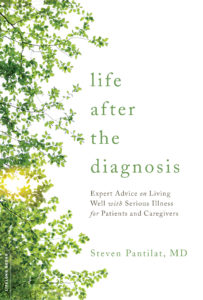Today, SevenPonds speaks with Dr. Steven Pantilat, a San Francisco-based healthcare professional with an expertise in palliative care. Dr. Pantilat teaches at UCSF, and consults with hospitals and other healthcare facilities on the best methods for improving communication about palliative care. His goal is to help doctors communicate more effectively with patients, allowing patients to make more informed decisions about their palliative care services. In addition to his work in the healthcare field, Dr. Pantilat has also published books about palliative care. He released a new book, “Life After the Diagnosis,” earlier this year.

Credit: cambriahealthfoundation.org
Marissa Abruzzini: It seems like many patients feel uncomfortable talking about palliative care. What can they do to mitigate their fear of saying “No” to aggressive treatments for terminal illnesses?
Dr. Steven Pantilat: It’s important to realize that as you get sicker, the chances you will benefit from a treatment go down. But you are as likely, if not more likely, to have bad side effects. You may think to yourself, “Well things can’t get any worse.” But they can. Not accepting every possible treatment isn’t giving up. It’s facing the reality and prioritizing things that really matter.
Palliative care is the one treatment proven to improve quality of life for people with serious illness with no side effects. Studies show that people with serious illness who get palliative care live as long, and sometimes longer, than people who don’t receive palliative care. If you have a serious illness, you should definitely get palliative care.
Marissa: Are you noticing a change in how medical professionals handle palliative care and the treatment of terminal illnesses?
Dr. Pantilat: Palliative care is becoming mainstream. More doctors are talking about it and more patients are asking for it. As we have more open and honest conversations about serious illness and the end of life, people will get better care that is consistent with their values and goals. It doesn’t mean they won’t still choose invasive treatments. They often will, as those treatments will have a good chance of helping. But they will understand their choices better and make better choices. They will also be able to think about how choices about treatment impact quality of life and make quality of life as important a goal (if not more important) than just treating the illness.
Marissa: I want to talk about your newest book, “Life After the Diagnosis.” What made you want to write this book? 
Dr. Pantilat: My hope in writing “Life After the Diagnosis” was that readers would get a detailed, concise and compassionate guide through serious illness with clear information that they can’t simply Google. I wanted to share what I have learned in over 28 years of practice caring for thousands of people with serious illness. My greatest hope is that “Life After the Diagnosis” will help people with serious illness live as well as possible for as long as possible, and that the experience of serious illness will be a bit less stressful, painful and scary for people who are sick, and for their loved ones as well.
Marissa: What’s an example of a good palliative care plan? Can you think of any patients you’ve worked with who made these sort of decisions?
Dr. Pantilat: Yes. My patient, Mary, was 82 years old. Mary had very serious heart failure. She’d been in the hospital many times, and this last time really took a lot out of her. The doctors were offering open heart surgery, which would be risky with a very long recovery and a real chance that Mary would die during or soon after the operation. Mary decided to go home and think about it.
I visited Mary and her daughters at home, and Mary talked about what was most important to her: staying in her home, being with family and enjoying whatever time she had left. She didn’t like being in the hospital. Over time it became clear that Mary just
didn’t think the operation would help, and wanted to focus on her quality of life — including her nightly glass of wine that her daughters were worried would make her fall, but that she really loved anyway.
One night, about nine months after her last hospitalization, Mary had her nightly wine, played Scrabble with her daughters and went to bed. She died peacefully in her sleep.
At first it was hard for Mary to decide what to do. As she settled in to her home and found that she really was enjoying her life day-to-day, it became clear to her that surgery just wasn’t right. Mary had a really good nine months, then died peacefully in her sleep (as many people hope to).
Marissa: What lessons can people take away from a story like Mary’s?
Dr. Pantilat: If you have serious illness, get palliative care early. It’s the single best thing you can do for you and your loved ones to live well and long.
If you missed part one of our interview with Dr. Steven Pantilat, you can read it here.

 How Can Palliative Care Improve Quality of Life?
How Can Palliative Care Improve Quality of Life?



 Composting Bodies Is Now Legal in a Dozen States
Composting Bodies Is Now Legal in a Dozen States
 “Hand to Earth” by Andy Goldsworthy
“Hand to Earth” by Andy Goldsworthy














